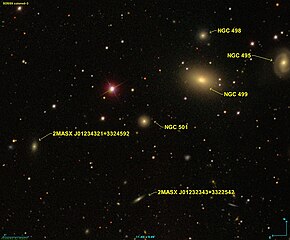NGC 501
Appearance
| NGC501 | |
|---|---|
 SDSSview of NGC 501 | |
| Observation data (J2000[1]epoch) | |
| Constellation | Pisces[2] |
| Right ascension | 01h23m22.4s[3] |
| Declination | +33° 25′ 59″[3] |
| Redshift | 0.016561 ± 0.000227[1] |
| Heliocentric radial velocity | (4924 ± 68) km/s[1] |
| Distance | 224Mly[4] |
| Apparent magnitude(V) | 14.5[2] |
| Apparent magnitude(B) | 15.5[2] |
| Characteristics | |
| Type | E0[2] |
| Apparent size(V) | 0.5' × 0.5'[2] |
| Other designations | |
| PGC5082,GC284,2MASSJ01232240+3325582[1][5] | |
NGC 501,also occasionally referred to asPGC5082orGC284,is anelliptical galaxyin the constellationPisces.[2]It is located approximately 224 million light-years from theSolar System[4]and was discovered on 28 October 1856 byIrishastronomerR. J. Mitchell.[5]
Observation history
[edit]AlthoughJohn Dreyer,creator of theNew General Catalogue,credits the discovery toastronomerWilliam Parsons, 3rd Earl of Rosse,he notes that many of his claimed discoveries were made by one of his assistants. In the case of NGC 501, the discovery was made by R. J. Mitchell,[5]who discovered it using Lord Rosse's 72 "reflecting telescopeatBirr CastleinCounty Offaly,Ireland.[6]The object was described "very faint, small (E inBirr diagram) "in the New General Catalogue.[5]
See also
[edit]References
[edit]- ^abcd"NGC 501".Retrieved2017-12-09.
- ^abcdef"Revised NGC Data for NGC 501".spider.seds.org.Retrieved2017-10-05.
- ^ab"Your NED Search Results".ned.ipac.caltech.edu.Retrieved2017-10-05.
- ^abAn object's distance from Earth can be determined usingHubble's law:v=Hois Hubble's constant (70±5 (km/s)/Mpc). The relative uncertainty Δd/ddivided by the distance is equal to the sum of the relative uncertainties of the velocity andv=Ho
- ^abcd"New General Catalog Objects: NGC 500 - 549".cseligman.Retrieved2017-10-16.
- ^"Photos".klima-luft.de.Retrieved2017-12-09.
External links
[edit]Wikimedia Commons has media related toNGC 501.
- NGC 501 onWikiSky:DSS2,SDSS,GALEX,IRAS,Hydrogen α,X-Ray,Astrophoto,Sky Map,Articles and images
- SEDS
